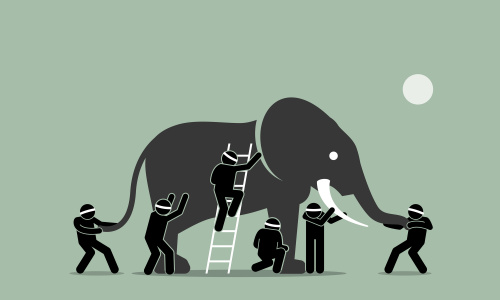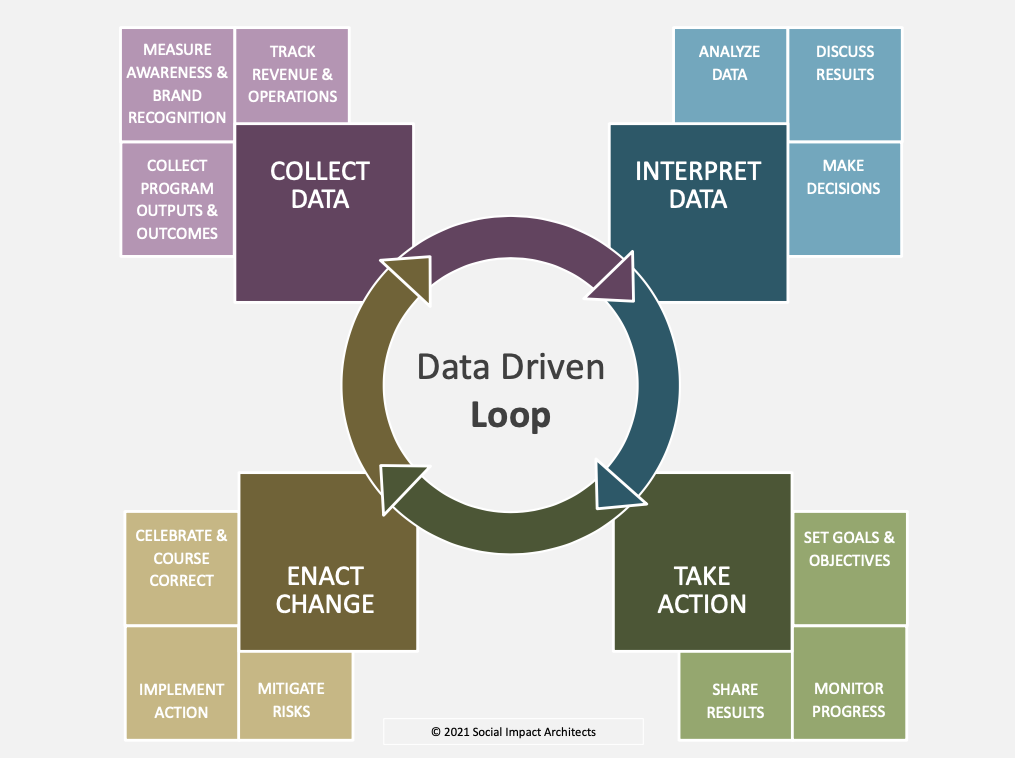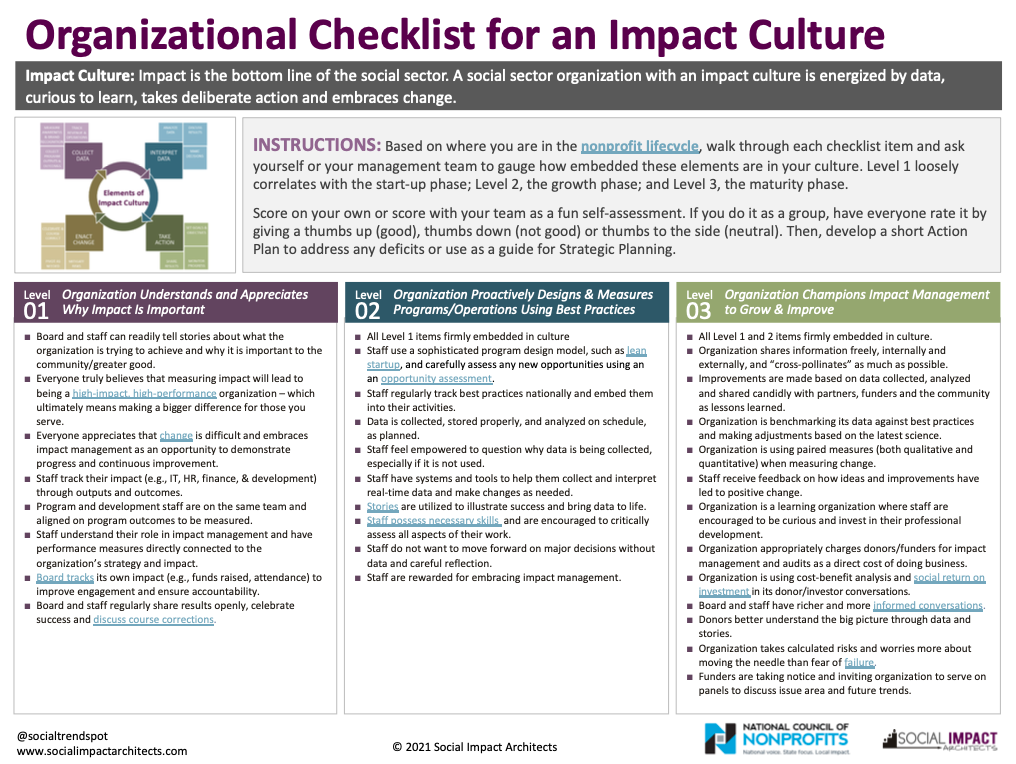
photo courtesy of DepositPhotos
In January 2018, we named it the year of collaboration. We practice what we preach by collaborating with partners to ensure the social sector gets easy-to-digest, actionable information to energize our work. We partnered with one our favorite like-minded partners, National Council of Nonprofits, to better define “Impact Culture, which includes a downloadable Organizational Checklist for an Impact Culture. This is what the social sector is all about – co-creation and continuous improvement. As we start a new year, we thought we would share our refreshed post on the topic, along with our impact checklist, with you again today. If you have already used the checklist, please let us know. We would love to hear your success stories and suggestions. If not, read on and enjoy.
I just love the ancient parable about the elephant. Six blind men were asked to describe an elephant by touching its body parts. The first man felt its side and described the elephant as a wall, the second man touched its tusk and thought it was a spear, the third man felt its trunk and was confident it was a snake, the fourth touched the knee and believed it was a tree, the fifth felt the ear and thought it was a fan and, finally, the sixth held the tail and assumed the elephant was a rope. None of the blind men was wrong in his analysis because each was perfectly describing the body part he touched and felt.
The problem came from their limited perception – they believed that they understood the situation, which led each of them to a mistaken conclusion. They missed the big picture – they were petting an elephant! The same applies to making data-driven decisions. When we have limited data and information, we don’t get the whole picture. And, the same is true in reverse – often when you get the big picture, you miss out on all the parts that go into its creation.
We often say, “Impact is the bottom line of the social sector.” But, what does that mean? Impact is the figurative elephant in the room these days. We have been working to break down this important concept and make it real and sustainable for nonprofits. Interestingly, we have found that impact isn’t driven by systems. You can buy all the fancy tools and hire evaluation experts, but we have found that impact is best supported by a data-driven culture supported by the right systems.
We have spent the past five years studying and working alongside clients on this very question. How can you build an impact culture* that is energized by data, curious to learn, takes deliberate action and embraces change?
At Social Impact Architects, we strive to transform the most overwhelming content into easy-to-digest information, so we decided to create an Organizational Checklist for an Impact Culture. It is self-scoring, but in general your score should be connected to where you are in the nonprofit lifecycle. Level 1 loosely correlates with the start-up phase; Level 2, the growth phase; and Level 3, the maturity phase. Score on your own or score with your team as a fun self-assessment. Or, try what we do in our workshops: walk through each checklist item and ask everyone to give a thumbs up, thumbs down or thumbs to the side to gauge how embedded these elements are in your culture. Then develop a short Action Plan to address any deficits or use as a guide for Strategic Planning.
Level 1: Organization Understands and Appreciates Why Impact Is Important
Board and staff can readily tell stories about what the organization is trying to achieve and why it is important to the community/greater good.
Everyone truly believes that measuring impact will lead to being a high-impact, high-performance organization – which ultimately means making a bigger difference for those you serve.
Everyone appreciates that change is difficult and embraces impact measurement as an opportunity to demonstrate progress and continuous improvement.
Staff track their impact (e.g., IT, HR, finance, & development) through outputs and outcomes.
Program and development staff are on the same team and aligned on program outcomes to be measured.
Staff understand their role in impact measurement and have performance measures directly connected to the organization’s strategy and impact.
Board tracks its own impact (e.g., funds raised, attendance) to improve engagement and ensure accountability.
Board and staff regularly share results openly, celebrate success and discuss course corrections.
Level 2: Organization Proactively Designs and Measures Programs & Operations Using Best Practices
All Level 1 items firmly embedded in culture.
Staff use a sophisticated program design model, such as lean startup, and carefully assess any new opportunities using an opportunity assessment.
Staff regularly track best practices nationally and embed them into their activities.
Data is collected, stored properly and analyzed on schedule, as planned.
Staff feel empowered to question why data is being collected, especially if it is not used.
Staff have systems and tools to help them collect and interpret real-time data and make changes as needed.
Stories are utilized to illustrate success and bring data to life.
Staff possess necessary skills and are encouraged to critically assess all aspects of their work.
Staff do not want to move forward on major decisions without data and careful reflection.
Staff are rewarded for embracing impact measurement.
Level 3: Organization Champions Impact Measurement to Grow & Improve
All Level 1 and Level 2 items firmly embedded in culture.
Organization shares information freely, internally and externally, and “cross-pollinates” as much as possible.
Improvements are made based on data collected, analyzed and shared candidly with partners, funders and the community as lessons learned.
Organization is benchmarking its data against best practices and making adjustments based on the latest science.
Organization is using paired measures (both qualitative and quantitative) when measuring change.
Staff receive feedback on how ideas and improvements have led to positive change.
Organization is a learning organization where staff are encouraged to be curious and invest in their professional development.
Organization appropriately charges donors/funders for impact measurement and audits as a direct cost of doing business.
Organization is using cost-benefit analysis and social return on investment in its donor/investor conversations.
Board and staff have richer and more informed conversations.
Donors better understand the big picture through data and stories.
Organization takes calculated risks and worries more about moving the needle than fear of failure.
Funders are taking notice and inviting organization to serve on panels to discuss issue area and future trends.
We hope you have found this checklist helpful and inspiring as you build an impact culture. In our experience, an impact culture goes beyond mere words and good intentions. It requires deliberate actions – with the right forms of accountability – at all levels of the organization to encourage, support and implement it. We’d love to hear your thoughts on the checklist and how you measure your organization’s impact culture.
* Many have asked us why we use impact management/measurement vs. evaluation. Two reasons: first, words matter. How do you feel when you are evaluated? Not good. Second, evaluation doesn’t go far enough. When you ask people to define it, it has limiting factors – reactive vs. proactive, success vs. failure or good vs. bad. To energize people toward measurement and continuous improvement, we have found that the word evaluation DOES NOT work. And, yes, we have evaluated the word “evaluation,” which makes us total geeks.
Sign up to receive the Social TrendSpotter e-newsletter


